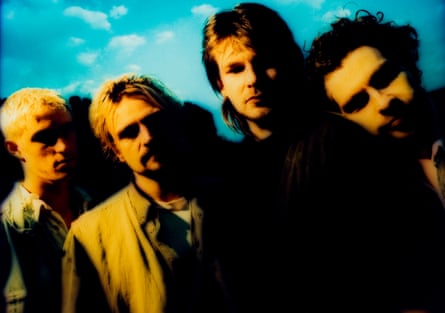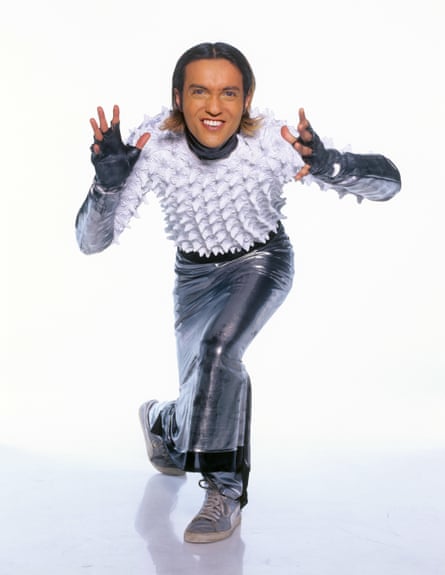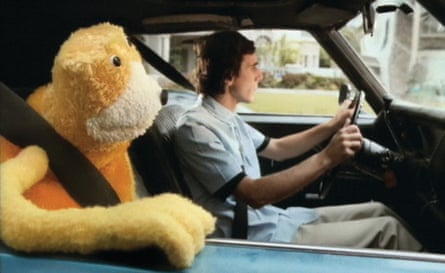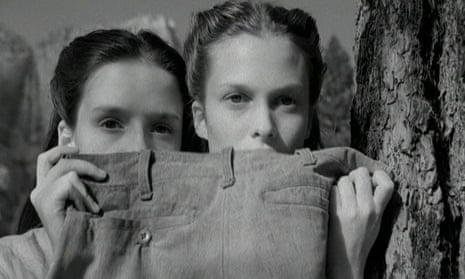Amid black and white Ansel Adams-style cinematography, two Amish sisters spy on a topless man bathing in a Yosemite river. Suddenly, a peaceful choral soundtrack gives way to bone-shaking guitar: Inside, the debut single by Scottish grunge band Stiltskin.
Thus began one of the strangest cultural wrinkles of the 1990s: when Levi’s became a jeans company that could also score UK chart hits. Inside was built around an addictive riff that still sounds fresh, and the advert, entitled Creek, shot it to the top of the UK charts. Over the next few years, the likes of Babylon Zoo, Smoke City, Mr Oizo and Norman Cook’s pre-Fatboy Slim project Freak Power would also score major success off the back of a placement in Levi’s witty, often sexually provocative adverts.
Before Stiltskin, previous Levi’s ads had made renewed hits out of Muddy Waters’ Mannish Boy, the Clash’s Should I Stay or Should I Go and Marvin Gaye’s I Heard It Through the Grapevine (the latter in 1985’s classic, Nick Kamen-in-his-boxers “Laundrette” ad). The brand used classic blues, rock and soul to embody the brand’s sense of vintage authenticity. Inside, though, was the first time the company had used a new artist as their soundtrack.
“When you’re selling the same basic product in the world of fashion, you have to change something,” explains Sir John Hegarty, the creative director at London-based creative agency Bartle Bogle Hegarty (BBH), who ran the 80s and 90s Levi’s campaigns. “You can’t change the clothes. So we used the communication as a way of saying: we’re discovering music, we’re ahead of fashion.”

“My house was being repossessed because I couldn’t pay the mortgage,” says Stiltskin singer (and later Genesis vocalist) Ray Wilson, recalling his audition for the band in January 1994. “I signed on the dole and drove down to London in this old Volkswagen van that was falling apart. Weeks after, we were No 1.” Released 20 days after Kurt Cobain’s suicide, the song landed in a musical landscape overrun with grunge bands emulating the 90s Seattle sound. Smashing Pumpkins frontman Billy Corgan, convinced Inside ripped off their sound, greeted a Munich crowd later that year with a wry, “Hi, we’re Stiltskin!”
The band never had another hit, something Wilson chalks up to “too much success too quickly. You can’t go up from there – it’s not the best way to start a band’s career. We came together within weeks, so we didn’t have a relationship. We ended up hating each other.” That anger bled into the band’s performances. “We did MTV’s Most Wanted and we were told there was something in the region of 20 million viewers,” he continues. “Me and [guitarist and songwriter] Peter were at each other. He kicked me in the face. On one hand MTV were pissed off, but that little clip of Peter kicking me and the microphone flying out of my hand – they used that for 12 months on their trailers.”
Having your track selected by Levi’s was enough to at least guarantee a chart hit, albeit not longevity – but even fleeting success was a temptation. “The music industry went from: ‘I don’t want to touch advertising’, to completely swinging round to: ‘Please can we have some of our music in your ad’,” recalls Hegarty.
“It was that winning-the-lottery phone call,” says Fatboy Slim, AKA Norman Cook, who, in 1995, was playing keyboards in acid-jazz troupe Freak Power. “We were slogging around clubs playing gigs and frankly, we weren’t setting the world alight. We needed something to kick us up a division.”
Turn On, Tune In, Cop Out had reached No 29 when it was first released, but went Top 5 after being re-released and selected to feature in the 1995 Levi’s ad Taxi. The commercial showed Filipino-American fashion designer Zaldy, now better known for making RuPaul’s outfits on Drag Race, taking a New York taxi in drag, and shocking the cab driver by shaving her chin mid-drive. Airing at a time when there was little in the way of LGBTQ+ representation in advertising, it was almost banned by the Advertising Standards Authority, who finally agreed it could be shown after 8pm. “The main client [at Levi’s] at the time was like, ‘Oh my god, we can’t do this’,” remembers Hegarty. “The people underneath him had to go and convince him it was going to be great.”
“There was one cut I really liked where the whole track stops when the shaver came on, which also sounded kind of like a vibrator,” says Cook. “I was very proud of the fact it had this slightly risque subject matter [for the time].”
Most people who grew up in the 90s will cite Babylon Zoo’s 1995 industrial-glam hit Spaceman as the Levi’s ad song they remember best. Although, as Hegarty reveals, the collaboration almost didn’t happen. “[Vocalist Jas Mann] didn’t want to do it and his manager said, ‘Are you fucking stupid? This is going to make you’.” It would go on to become the fastest-selling British single since the Beatles’ Can’t Buy Me Love, despite widespread disappointment that the pitched-up snippet in the ad wasn’t representative of the overall track. “Millions of pop kids rushed down Woolies and bought the single – only to get it home to discover to their horror that it was ‘good’ (like in the advert) for about 10 seconds,” Steven Wells wrote in the NME. “Then became rubbish. Very rubbish.”

Still, the Levi’s cachet continued to rise through the 1990s, and BBH commissioned well-known names to helm their commercials. In 1997, Roman Coppola directed the Brady Bunch-inspired commercial Daytrippers, soundtracked by US indie band Lilys’ psych-pop track, A Nanny in Manhattan. The song reached No 16 in the UK – their only major chart success. Vocalist Kurt Heasley remembers he felt pressured to follow up with music people could “instantly grasp by the second chorus. We’re this weird, rare, odd thing and people were like, ‘More meat! More potato!’ We’re more like truffle oil on chips.”
Also in 1997, Michel Gondry, who would later direct Eternal Sunshine of the Spotless Mind and more, was hired to film the raunchy spot Mermaids. For Smoke City’s Brazilian-British vocalist Nina Miranda, Gondry’s sensual advert, which featured a pod of mermaids attempting to relieve a man of his Levi 501s in the ocean, conjured a sense of escapism. “Levi’s ads were weird little messages in a bottle from an exotic place somewhere else,” she says.
Miranda had written the track in 1993, long before Levi’s came calling: “I was really depressed and living in London. I used to sit in my room, putting ideas to tape. A DJ friend said: ‘I’m going to make a song just for you’. I put it on, without having heard it before, and I sang what I felt which was this incredible trip into water.” Underwater Love became an underground hit and sparked a bidding war – but once signed to Zumba Records, Smoke City were frustrated to find the label wouldn’t promote their debut album, Flying Away, after the Levi’s ad was confirmed, because they considered the ad such an effective marketing tool on its own.
“We were saying, ‘please promote the album’, because already people were saying we were one-hit wonders,” Miranda remembers, though she believes the commercial was still a blessing rather than a curse. “That song went all over the world. It opened a lot of doors and people still remember it.”
BBH’s final Levi’s ad of the 90s would be their most successful of the decade. It featured a headbanging, fluffy yellow puppet called Flat Eric. Soundtracked by Flat Beat, French DJ-producer Mr Oizo’s influential bass anthem, it was a concept Hegarty had to pitch three times in order to get over the finish line. The single sold millions of copies, spent two weeks at No 1 in March 1999, and spawned think pieces that pondered Flat Eric’s position at the intersection of consumerism and popular culture.

But Flat Beat would be the last song to become a major hit after appearing on a Levi’s ad and BBH turned away from using original artists in the 2000s. That 90s run is a feat Hegarty thinks could never happen again. “The way advertising works today, it doesn’t have quite the confidence – or if I can use that word ‘swagger’ – as it had back then,” he says. “People have lost confidence in those big brand statements about what we are, who we are, how we behave.”
“I suppose the modern equivalent would be to have a TikTok hit,” says Cook, who recently pondered joining the social network with his manager and label. “We went to TikTok and asked, ‘We know how to get records on the radio, but how do we get them here?’ And they said, ‘They just grow ergonomically or organically.’ It’s not an algorithm that can be influenced.”
The difference, Hegarty says, is the way that the world is fragmented today through social media. “There’s always a relationship between music and clothing – the trouble is you’ve not got anyone going out there making a big statement about it and leading the market,” he says. “Someone always says to me, ‘How do you predict fashion?’ You can’t predict fashion. What you can do is write interesting, challenging, distinctive little stories and that way, you might have an influence.”

Comments (…)
Sign in or create your Guardian account to join the discussion